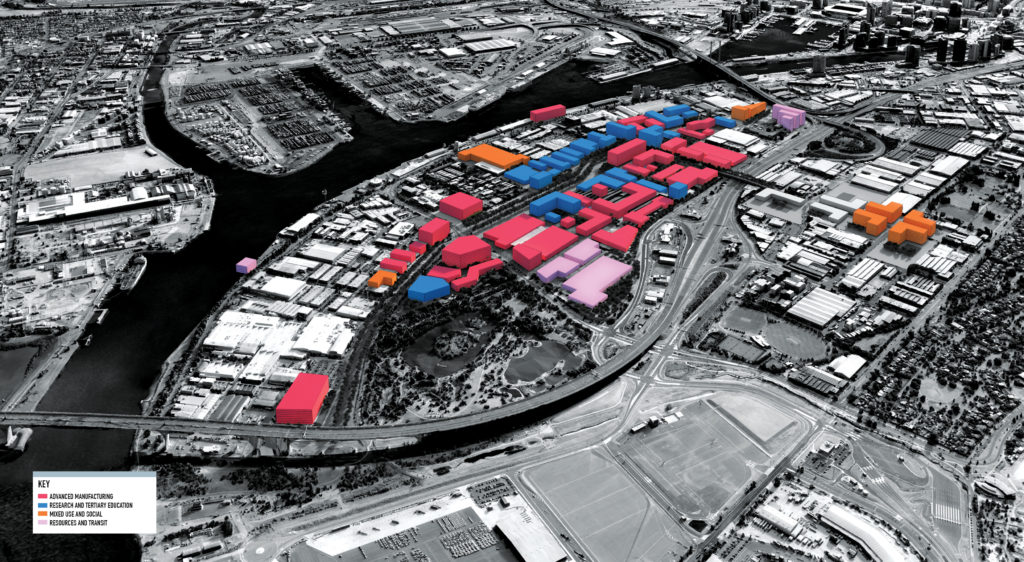Building a globally competitive employment and innovation cluster
Melbourne’s Fishermans Bend precinct is set to be transformed into a world-class employment and innovation cluster with up to 55,000 high-tech jobs.
Melbourne is a city undergoing unprecedented growth coupled with rapid technological disruption, and it is also home to one of the world’s highest-potential urban redevelopment precincts. The regeneration of the Fishermans Bend precinct into an employment and innovation cluster (EIC) could be worth up to $12 billion in additional annual gains to the economy of the State of Victoria by 2030. As such, it not only represents one of Australia’s biggest urban-renewal developments, it also provides Melbourne with an incredible opportunity to demonstrate its economic competitiveness and technological leadership in the ‘4th Industrial Revolution’.
AECOM’s report, Transforming Fishermans Bend: Unlocking innovation and jobs for Melbourne, lays out a vision for a high-performing EIC, and sets out recommendations for investments and strategies to realise a successful transformation. This report builds on the earlier findings from our report, Transforming Melbourne and Victoria with Employment and Innovation Clusters.
Our investigation begins with a single question: How can the Fishermans Bend employment precinct develop to become a globally significant employment and innovation cluster, and thereby drive Melbourne into a prominent position within the emerging global knowledge economy?
To do this, we looked at three different development scenarios for the Fishermans Bend employment precinct through to 2030 — an ‘enhanced’ EIC scenario applying our recommendations; a ‘current’ scenario modelling the Fishermans Bend Taskforce’s framework that is in place; and a ‘fragmented’ scenario with no special planning conditions. By rating each of the three approaches through applying our Urban Precinct Investment Tool, the investment required and range of benefits of each scenario can more easily be compared and contrasted. We found that our ‘enhanced’ EIC scenario has exceptional potential to achieve a far greater economic return and greater social and environmental performance than the other two. Moreover, up until 2030 the capital costs across the three scenarios are broadly similar, but what is most critical for success is how the investment is spent and who is attracted to the site.
Bringing together startups, established businesses, researchers and service providers, EICs from Boston to Barcelona have created a catalyst for commercialising research and creating innovative products and services benefitting people, while supporting strong economic growth and a higher standard of living for local communities.
Melbourne faces a stark choice: either up our game to meet the challenges posed by rapid growth of about 125,000 new residents per year as well as accelerating technological change, or be left behind other leading cities in the race to succeed in the decades to come. Our report emphasises how forward planning and collaboration will drive more jobs, improved innovation outcomes and a higher standard of living for all Melburnians.
Fishermans Bend has one of the highest-potential opportunities for developing a leading innovation precinct in Australia and that developing Fishermans Bend will have a significant impact on Victoria’s economy and jobs in the state. Indeed, by 2030 we envision Fishermans Bend employing over 55,000 mostly high-skilled workers, including entrepreneurs and researchers, engaged in commercialising the best of Melbourne’s research discoveries and creating new goods and services for export around the world.


The emergence of an EIC will shift economic development toward businesses of greater value per job to the local economy, hence the significant improvement in economic performance. The five key industries that Fishermans Bend should aim to foster include: advanced manufacturing; tertiary education, research and scientific services; standard manufacturing; wholesale trade, transport and warehousing; and professional, financial and technical services. Fishermans Bend should aim to be especially attractive to universities and other institutions of higher-education, with an aim of fostering global cooperation in research through attracting global research institutions, and in turn paving the way for the commercialisation of that research. The key strategies needed to prepare Fishermans Bend for making the leap to an EIC centred on these industries include:
- Supporting local talent and averting a skills shortage
- Commercialising research
- Improving social cohesion
- Making it easier to move around the precinct and Melbourne, as well as making freight-transport more efficient
- Opening up the waterfront and making the precinct more resilient to flooding
- Constructing world-class urban environments, using more-sustainable energy, waste and water systems, whilst also providing world-class Internet connectivity.
Our report sets out a list of 10 specific recommendations that will support the development of the Fishermans Bend precinct and help create a bright future for innovation in Melbourne. These range from developing a governing and coordinating authority for the whole precinct to attracting international, as well as local, university campuses to opening up sections of the precinct’s extensive waterfront to the public in collaboration with the Port of Melbourne.
Everyone with an interest in developing Fishermans Bend, from government stakeholders, to private landholders, to educational institution, to startup entrepreneurs want to see the precinct contribute strongly to Melbourne’s global success. Melbourne has all of the ingredients, from home-grown technology talent to world-class advanced research, to move up the global league table of innovative cities. Smart, targeted investments in the Fishermans Bend EIC, along with more-coordinated efforts to commercialise the incredible research being conducted at our leading universities, will have an outsized impact on creating a stronger, more-vibrant city and on lifting Melbourne’s global standing as a leading centre of innovation.
To download Transforming Fishermans Bend, please visit aecom.com/au/tfb.






